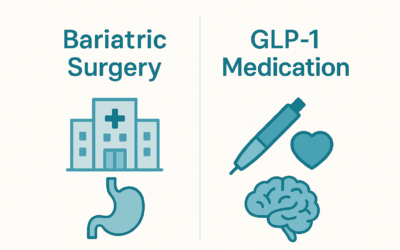Trying to lose weight in 2025 can feel like scrolling an endless menu of promises: keto hacks, detox teas, bio-hacked workouts. Yet the most powerful breakthrough isn’t a fad at all—it’s medicine. Modern, FDA-approved weight-loss drugs are helping people shed 15–22 percent of their body weight and keep it off. But which prescription is right for you? And how do you get started safely?
This guide walks you through today’s top prescription weight-loss medications, how they work, who they help, and what to expect when you begin treatment with a trusted telehealth partner like Claya.
Understanding How Prescription Weight-Loss Drugs Work
Prescription anti-obesity medications do far more than “shut off hunger.” Each class targets specific biology:
- Appetite regulation. GLP-1 receptor agonists (e.g., semaglutide, tirzepatide) mimic a hormone that signals fullness to your brain and slows stomach emptying.
- Blood-sugar balance. By smoothing post-meal glucose spikes, these drugs curb cravings and reduce fat storage.
- Calorie absorption. Older agents such as orlistat block some dietary fat from being digested.
- Central-nervous stimulation. Phentermine-based medicines boost norepinephrine to tamp down appetite temporarily.
In short, medication gives your physiology a fighting chance while diet and exercise handle the behavior change.
“Weight-loss drugs aren’t magic—but they are game-changers when paired with lifestyle coaching,” says Dr. Sara Kim, MD, obesity-medicine specialist at Claya (interview, May 2025).
Who Qualifies for a Prescription?
The FDA green-lights weight-loss medication for adults with a BMI ≥ 30, or BMI ≥ 27 plus a related condition (type 2 diabetes, hypertension, sleep apnea, etc.). A licensed clinician must also rule out contraindications such as pregnancy or uncontrolled thyroid disease.
According to the CDC, 42 percent of U.S. adults live with obesity—meaning millions are eligible yet untreated. Telehealth platforms like Claya close that care gap by offering rapid, evidence-based prescribing without a trip to the doctor’s office.
2025’s Top Prescription Weight-Loss Drugs
Below are the medications currently delivering the biggest results. All require a doctor’s prescription and ongoing monitoring.
1. Wegovy® (semaglutide)
- Weekly subcutaneous injection
- Average 15–20 % body-weight reduction
- Cardiovascular-risk reduction in new studies
- Most common side effects: nausea, transient fatigue
2. Zepbound™ (tirzepatide)
- Once-weekly injection, dual GIP/GLP-1 action
- Up to 22.5 % weight loss in SURMOUNT-1 trial
- Also improves A1c for patients with type 2 diabetes
- Claya offers a dedicated tirzepatide program for eligible members
3. Oral Semaglutide (Rybelsus® weight-management dose)
- First GLP-1 pill approved for obesity (awaiting final FDA label)
- Similar efficacy to injectable semaglutide when taken daily on an empty stomach
- Ideal for anyone hesitant about needles
4. Saxenda® (liraglutide)
- Daily GLP-1 injection
- 5–10 % average weight loss, long safety record since 2014
- Often covered by insurance when newer drugs aren’t
5. Qsymia® (phentermine/topiramate)
- Oral, once-daily capsule
- Dual mechanism: appetite suppression + satiety boost
- 9–11 % average weight loss over 12 months
- May cause insomnia or tingling; not for patients with heart disease
Figure 1. Comparison of Leading Weight-Loss Drugs
Alt: Table comparing dose schedule, average weight loss, and common side effects for five prescription medications.
AI prompt: “Clean infographic table, blue clinical palette, icons for injection vs pill, weight-loss percentages in bold.”
Choosing the Right Medication for You
- Medical profile. Your clinician will review labs, medications, pregnancy plans, and mental-health history.
- Lifestyle fit. Can you remember weekly injections? Would a daily pill disrupt routines? Convenience drives adherence.
- Insurance & cost. List prices range from $25/month (phentermine) to $1,000+/month (GLP-1s). Many plans now cover GLP-1s; Claya’s weight-loss membership secures negotiated pharmacy discounts.
- Side-effect tolerance. Mild nausea is common with GLP-1s, while stimulants may raise heart rate. Your clinician will match risk profile to medication.
Pro tip: Use a simple scoring grid (effectiveness, cost, convenience, comfort). The “winner” often jumps off the page.
What to Expect Before, During, and After Treatment
Initial Telehealth Consultation
- 20-minute video visit with a board-certified provider
- Secure upload of weight, labs, and medical history
- Prescription sent electronically to your pharmacy of choice
First 12 Weeks (Titration Phase)
- Gradual dose increases minimize GI side effects
- Bi-weekly check-ins via secure messaging
- Food-log and activity-tracking inside Claya’s mobile app
Months 3–12 (Optimization Phase)
- Dose plateau once you hit therapeutic target
- Weight loss typically accelerates between weeks 16–36
- Nutrition coaching and exercise plans layered in for metabolic health
Beyond One Year (Maintenance Phase)
- Studies show continued dosing helps prevent regain
- Some patients shift to a lower maintenance dose or transition off under guidance
- Quarterly labs monitor A1c, lipids, and vitamin levels
Figure 2. The Weight-Loss Medication Timeline
Alt: Horizontal timeline from consultation through maintenance, showing milestones at 0, 3, 6, and 12 months.
AI prompt: “Modern timeline graphic, teal accents, icons for consult, dose increases, lifestyle coaching, long-term maintenance.”
The Future of Weight-Loss Pharmacotherapy
Pharma pipelines are buzzing with next-generation options:
- Orforglipron: first non-peptide oral GLP-1 analogue now in Phase III—no fasting window required.
- CagriSema: fixed-dose combination of semaglutide + cagrilintide aiming for even greater fat-mass reduction.
- Triple agonists: molecules that hit GLP-1, GIP, and glucagon receptors simultaneously. Early data suggest > 25 % weight loss.
Researchers are also exploring chronotherapy—timing doses with circadian rhythms—to maximize appetite control.
Key Takeaways & Next Steps
Prescription weight-loss drugs are rewriting what’s possible for people with obesity. The right medication can make lifestyle changes finally “stick,” turning small wins into lifelong health.
Ready to see if a prescription fits your journey? Book a weight-management consultation with Claya’s medical team today and take the first, evidence-based step toward a lighter, healthier future.



